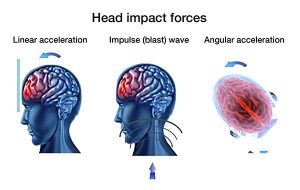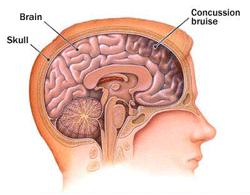You’ve hit your head, so what? Now you have a little headache, no big deal right? Wrong. Chances are if you experience a headache along with symptoms such as sensitivity to light and sound, along with issues concentrating after hitting your head, you have a concussion.
What is a concussion?
Most people, refer to a concussion as a brain bruise. This trauma to the brain is more than a little bruise. When a person’s head is hit, their brain sloshes around in their skull. Depending on the angle, and the force of the hit the concussion can range from mild, to severe or traumatic. The initial sloshing of the brain leads to an influx of ions in between different neurons. This abnormal activity between neurons leads to the activation to an immune response, and as a result histamine is released. This release of histamine results in inflammation, which in turn results in oxidative stress. This stress on the brain leads to the build up of toxic proteins which leads to cell death.
When a concussion happens, the membrane of the brain stretches there is an efflux of potassium, and an influx of calcium in the neurons. The rapid influx of calcium ions leads to excitotoxicity. At the same time there is an increase of glucose metabolism, and an increase in ATPase activity as the brain tries to get back to homeostasis. This hypermetabolism leads to increased protease activation. As the cascade of a concussion continues to happen the cell begins to run low on energy trying to fix all the problems that are simultaneously occurring. This leads to an energy crisis, and the neurofilament side-arms can now be phosphorylated which leads to the collapse of the axons. This collapse of the axons causes microtubule disruption, which in turn diminishes the normal signaling between neurons and the rest of the body.
Classification of TBIs and Recovery

Like people, no two concussions are the same. Depending on the force of the hit, and the location and area of the hit the class of the concussion changes. There are two main classes of traumatic brain injuries or TBIs.
- Mild
- Severe
Mild, have a faster recovery time than severe, and the symptoms displayed are less.
Studies have shown, that it takes adults 10-14 days to recover from a mild TBI, and children 18 and under take about 4 weeks to recovery. Of course, recovery time depends on the person and the severity of the concussion. There are five steps to recovery from a concussion.
- Acute Injury: This is the first 72 hours after a concussion. There may be some testing done at this step like the ImPACT test. During this time symptoms may evolve and change during this time.
- Initial Rest and Recovery: Initial testing such as the ImPACT test, a balance test, and a neuropsychology test, may be done at this time, and if necessary a care plan is created.
- “Hunker Down”: During this phase some days are worse than others, but in order to recovery in a healthy manner, you should take recovery a day at a time.
- Mountaintop: At this stage symptoms are mostly resolved, however, you should still take care to not go back to full exertion
- Transition: In this stage symptoms are gone. You can now resume all activities, and no longer worry about the TBI.
More than a bruise
If someone you know has experienced a concussion, and is slow to return back to “normal” remember….
A concussion is more than a bruise. Every time a concussion occurs the normal functions of the brain are disrupted. Additionally, each subsequent concussive event causes more damage than the previous one. Studies have shown that suffering from multiple concussions can leave you at a higher risk for, anxiety, depression, and Alzheimer’s Disease.
Images:
Image 1: https://crls.cpsd.us/athletics/sports_related_head_injury_and_concussions
Image 2: https://www.headsmart.me/
Image 3: https://concussionu.wordpress.com/concussion-management/
